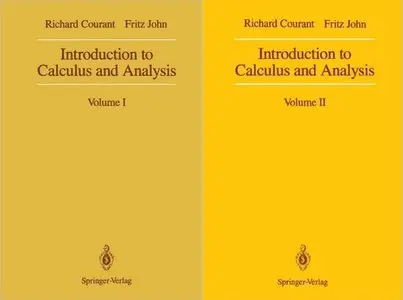Introduction to Calculus and Analysis: Volume I and II
by Richard Courant, Fritz John
English | 2011 | ISBN: 1461389577, 1461389607 | 661 + 954 pages | PDF | 21 + 19.72 MB
by Richard Courant, Fritz John
English | 2011 | ISBN: 1461389577, 1461389607 | 661 + 954 pages | PDF | 21 + 19.72 MB
From the Preface: (…) The book is addressed to students on various levels, to mathematicians, scientists, engineers. It does not pretend to make the subject easy by glossing over difficulties, but rather tries to help the genuinely interested reader by throwing light on the interconnections and purposes of the whole. Instead of obstructing the access to the wealth of facts by lengthy discussions of a fundamental nature we have sometimes postponed such discussions to appendices in the various chapters. Numerous examples and problems are given at the end of various chapters. Some are challenging, some are even difficult; most of them supplement the material in the text. In an additional pamphlet more problems and exercises of a routine character will be collected, and moreover, answers or hints for the solutions will be given. This first volume of concerned primarily with functions of a single variable, whereas the second volume will discuss the more ramified theories of calculus (…).
The new Chapter 1 contains all the fundamental properties of linear differential forms and their integrals. These prepare the reader for the introduction to higher-order exterior differential forms added to Chapter 3. Also found now in Chapter 3 are a new proof of the implicit function theorem by successive approximations and a discus sion of numbers of critical points and of indices of vector fields in two dimensions. Extensive additions were made to the fundamental properties of multiple integrals in Chapters 4 and 5. Here one is faced with a familiar difficulty: integrals over a manifold M, defined easily enough by subdividing M into convenient pieces, must be shown to be inde pendent of the particular subdivision. This is resolved by the sys tematic use of the family of Jordan measurable sets with its finite intersection property and of partitions of unity. In order to minimize topological complications, only manifolds imbedded smoothly into Euclidean space are considered. The notion of "orientation" of a manifold is studied in the detail needed for the discussion of integrals of exterior differential forms and of their additivity properties. On this basis, proofs are given for the divergence theorem and for Stokes's theorem in n dimensions. To the section on Fourier integrals in Chapter 4 there has been added a discussion of Parseval's identity and of multiple Fourier integrals.
Please No mirrors.



